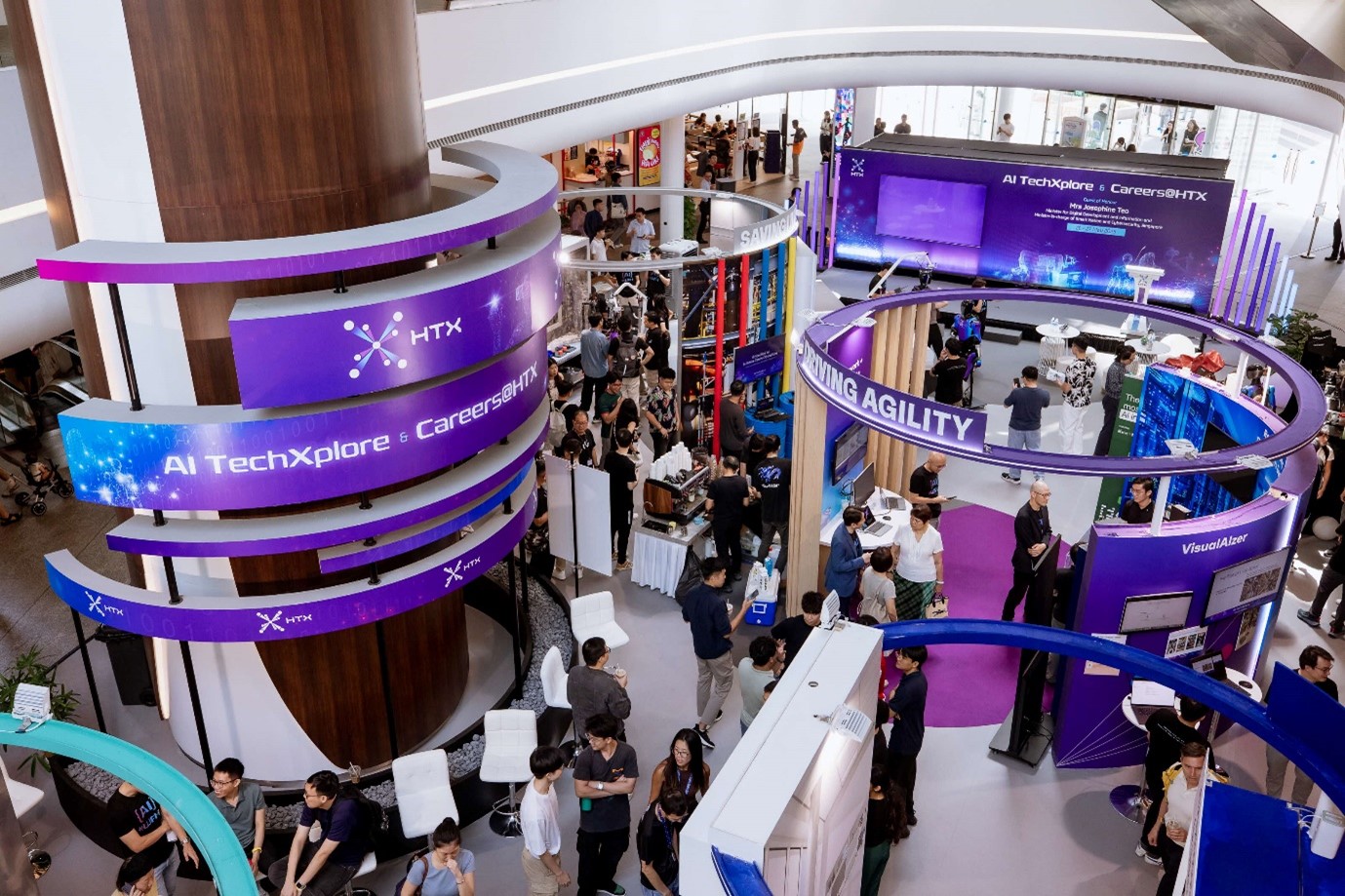 The exhibition atrium at AI TechXplore was bursting with innovation! (Photo: HTX)
The exhibition atrium at AI TechXplore was bursting with innovation! (Photo: HTX)
Visitors at HTX’s AI TechXplore, the artificial intelligence-themed edition of the agency’s biannual technology showcase series, got to interact with and learn about several of HTX’s cutting-edge AI solutions for the Home Team.
Held from 26-27 May 2025, the event featured four zones (themed Saving Lives, Solving Crimes and Securing Borders, Enhancing Public Safety and Security, and Driving Agility) showcasing 12 innovations that allow the Home Team’s frontline operations to be performed safer, smarter and more efficiently with AI.
Enhancing public safety
Been hearing the term “agentic AI” a lot lately? That’s because this form of AI is indeed making waves in the technology landscape. But what is that, exactly?
Agentic AI systems consist of autonomous and intelligent agents which use LLMs to perceive and understand context. These systems can also break down large objectives into smaller, simpler tasks, perform reasoning and provide decision support.
So, how is HTX leveraging this remarkable technology to empower the Home Team?
In the Multimodal and Agentic AI showcase, Alfred See, HTX’s Q Team Centre of Expertise engineer, shared that his team has developed an integrated system combining advanced video perception with autonomous decision-making to enhance video analysis and sensemaking in emergency response situations.
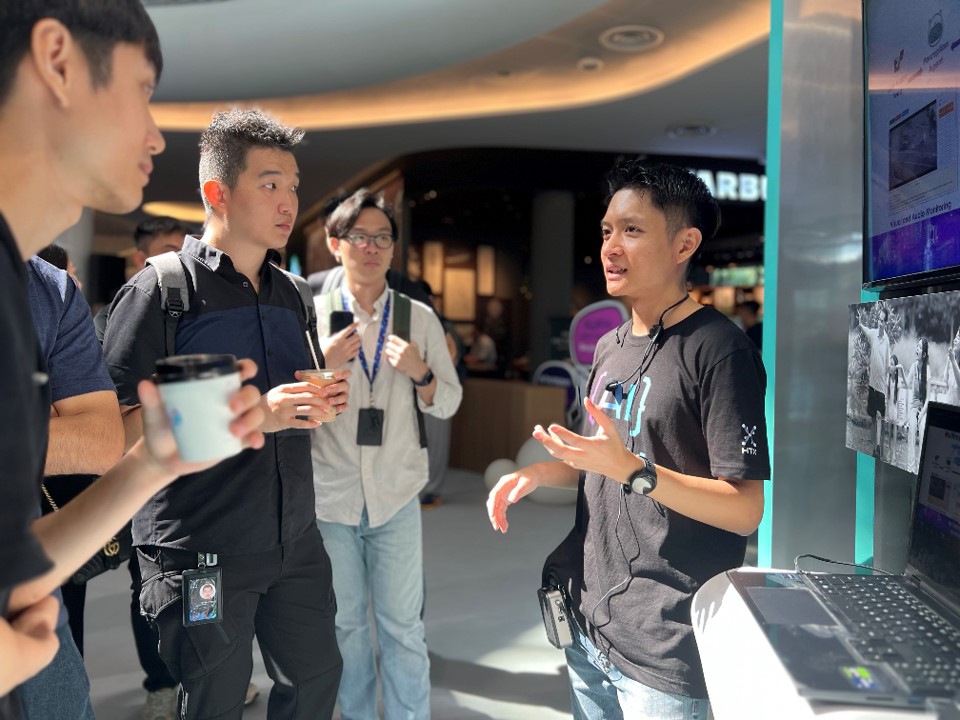 Alfred See (right) presents Multimodal and Agentic AI to visitors. (Photo: HTX/Janna Giam)
Alfred See (right) presents Multimodal and Agentic AI to visitors. (Photo: HTX/Janna Giam)
The system’s multimodal AI features can process both visual and auditory inputs to generate a comprehensive understanding of a video’s context, while its agentic AI features can interpret, reason and make informed decisions, even communicating with other agents to orchestrate processes and actions such as dispatching resources, relaying incident details or generating incident reports.
A demonstration of how the system would work in a fire response situation. (Video: HTX/Alfred See)
“This system will allow us to support our Home Team officers in real-time monitoring for emergency incidents, as due to the sheer number, there may be areas beyond their coverage,” said Alfred.
The Enhancing Public Safety and Security zone also showcased the AI Auditor for Call Centre, which leverages LLM capabilities to audit and identify high-risk call recordings between prison inmates and members of the public, as well as AI-Powered Fake Website Detection, which can help Home Team officers analyse large volumes of websites to detect malicious intent.
Saving lives
When it comes to planning for fire safety inspections, planners often need to know what happened during a previous fire incident and what other premises share similar characteristics to the one they are about to inspect.
To gather such info, Home Team officers typically have to trawl through large volumes of information. As you can imagine, this can be incredibly time-consuming.
And this is where the Fire Safety AI Assistant, one of the hi-tech solutions presented in AI TechXplore’s Saving Lives zone, can come in handy.
Designed to handle dynamic questions from Home Team officers, the tool combs through an extensive internal database of inspection records and risk assessment scores to answer, interpret and provide insights.
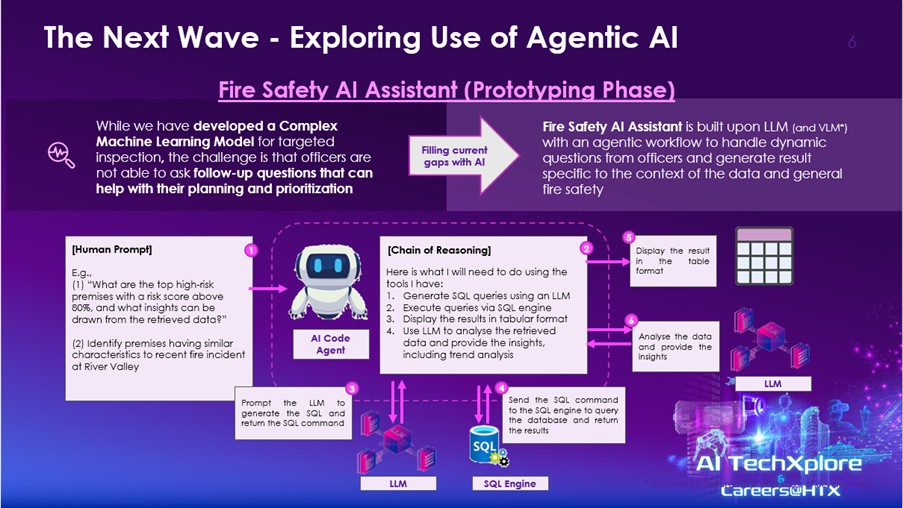 The next wave? The project team is exploring the use of agentic AI in the Fire Safety AI Assistant prototype. (Image: HTX/Yvonne Chua)
The next wave? The project team is exploring the use of agentic AI in the Fire Safety AI Assistant prototype. (Image: HTX/Yvonne Chua)
“Built on a Large Language Model (LLM) and driven by an agentic workflow, the tool can make data-driven decisions in the inspection planning process, enabling more targeted safety inspections,” explained Yvonne Chua, an engineer from HTX’s Sensemaking and Surveillance Centre of Expertise (S&S CoE).
“At its core, it uses the LLM to grasp context, understand intent and process textual data. Going beyond simple data retrieval, the agentic workflow supports multi-step reasoning and decision support by executing actions using a suite of suitable tools.”
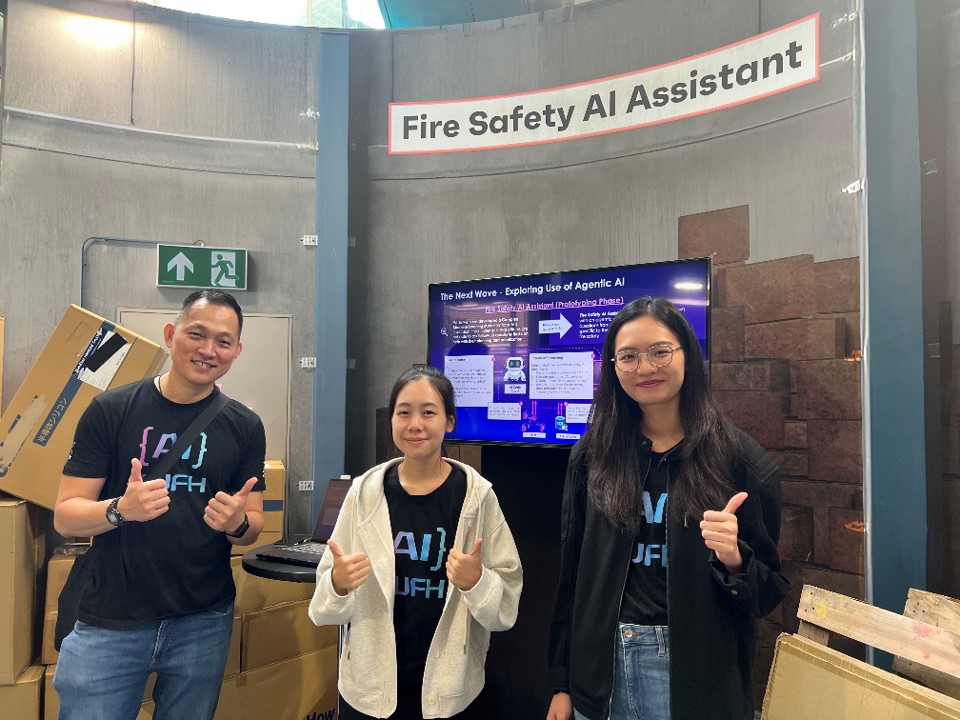 (From left) Project members from HTX’s S&S CoE, Chee Chin Khiam, How Kiah Min and Yvonne Chua, pose at their booth. (Photo: HTX/Janna Giam)
(From left) Project members from HTX’s S&S CoE, Chee Chin Khiam, How Kiah Min and Yvonne Chua, pose at their booth. (Photo: HTX/Janna Giam)
In the same zone, visitors also got a chance to see embodied AI in action with HTX’s newest humanoid robots.
Solving crimes and securing borders
With the rise of New Psychoactive Substances (NPS) – especially synthetic cannabinoids – authorities need faster and smarter ways to respond.
HTX’s in-house developed AI Psychoactivity Prediction for Unknown Substances system can rapidly predict whether a substance is likely to have mind or behaviour-altering effects, simply by analysing a substance’s molecular structure.
 An example of an unknown substance being flagged out as psychoactive by the system. (Image: HTX/Cheng Zhi Chao)
An example of an unknown substance being flagged out as psychoactive by the system. (Image: HTX/Cheng Zhi Chao)
“Through this innovative approach, we can dramatically reduce the time needed for preliminary screening of psychoactivity for better triaging of drug samples,” said Cheng Zhi Chao, a forensic scientist from HTX’s Forensics CoE who presented the solution in the Solving Crimes and Securing Borders zone.
 Cheng Zhi Chao (left) presents to visitors the game-changing AI system, which complements the pharmacological experiments conducted in HTX’s Forensic Innovation and Research for Strategic Transformation (FIRST) lab for drug exhibits. (Photo: HTX)
Cheng Zhi Chao (left) presents to visitors the game-changing AI system, which complements the pharmacological experiments conducted in HTX’s Forensic Innovation and Research for Strategic Transformation (FIRST) lab for drug exhibits. (Photo: HTX)
This system contributes to HTX’s goal of building a suite of AI-enabled tools to predict a wide spectrum of drug-related properties, which will allow Singapore to pre-empt, identify and neutralise threats from known and emerging illicit drugs.
 Amelia Tan from the S&S CoE poses at her booth. (Photo: HTX)
Amelia Tan from the S&S CoE poses at her booth. (Photo: HTX)
Another solution on display in this zone – AI for X-ray Image Detection – showed how HTX is securing Singapore’s borders.
It’s no secret that though cargo passing through our borders are screened by X-ray scanners, it is ultimately image analysts who have to pore through these X-ray images with the naked eye to detect any presence of anomalies.
Having to manually check so much cargo is no easy task, especially when cargo volumes are constantly rising – there was an 85 per cent jump in the number of images analysed between 2019 and 2024!
Again, our engineers have leveraged AI to help with this arduous process.
For this solution, HTX’s S&S CoE helped with the training and finetuning of AI models that can identify anomalies in X-ray images and detect contraband like alcohol and cigarettes, and weapons like firearms and knives.
Can you spot the contraband items in these X-ray images? See how the AI solution does it. (Video: HTX/Amelia Tan)
Driving agility
Over at the Driving Agility zone, large crowds gathered to check out Phoenix, the Home Team’s very own series of LLMs.
Pre-trained on a whopping 24-billion parameter scale and on extensive corpuses of knowledge specific and relevant to the Home Team and Singapore, Phoenix will be progressively deployed as an AI chatbot accessible to Home Team officers.
Why does the Home Team need its own chatbot? Because searching for information specific to the Home Team would be much quicker this way.
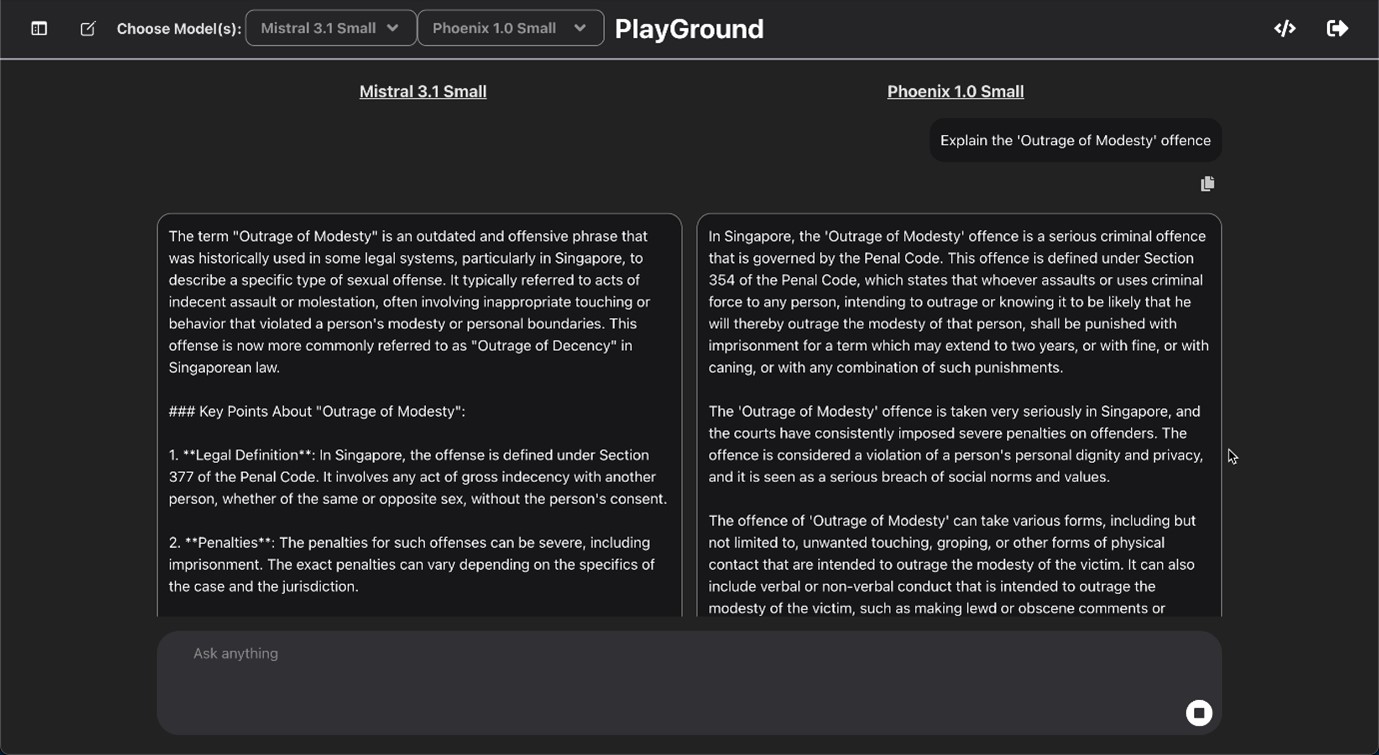 See how Phoenix’s outputs line up against that of another AI model. (Image: HTX/Tan Wen Xiu)
See how Phoenix’s outputs line up against that of another AI model. (Image: HTX/Tan Wen Xiu)
According to Tan Wen Xiu, an engineer with the Q Team CoE, Phoenix is also a big deal because not many people pre-train their own LLMs. Being able to do so, she added, makes HTX stand out and marks a significant step forward in establishing sovereign AI capabilities within the Home Team.
Other solutions showcased within the zone included Paperwork and Teammate, AI tools that can revolutionise acquisition processes from intelligent document generation to validation.
Also on show were VisualAlzer, which uses generative AI (GenAI) to help Home Team departments create localised and photorealistic content for public engagement, and Revolutionising Data Centre Design, which featured advanced infrastructure that ensures future data centres have sufficient power, cooling and space to support growing AI workloads.
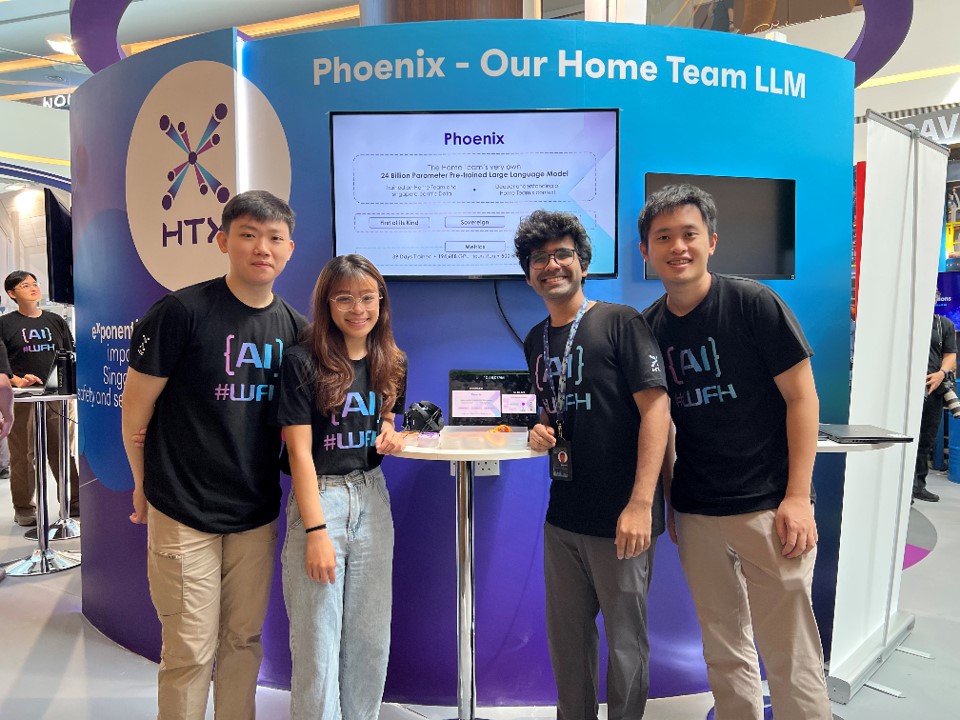 (From left) Q Team CoE engineers Biondi Lee, Tan Wen Xiu, Arka Ray and Tan Jun En stand at the booth for Phoenix. (Photo: HTX/Janna Giam)
(From left) Q Team CoE engineers Biondi Lee, Tan Wen Xiu, Arka Ray and Tan Jun En stand at the booth for Phoenix. (Photo: HTX/Janna Giam)
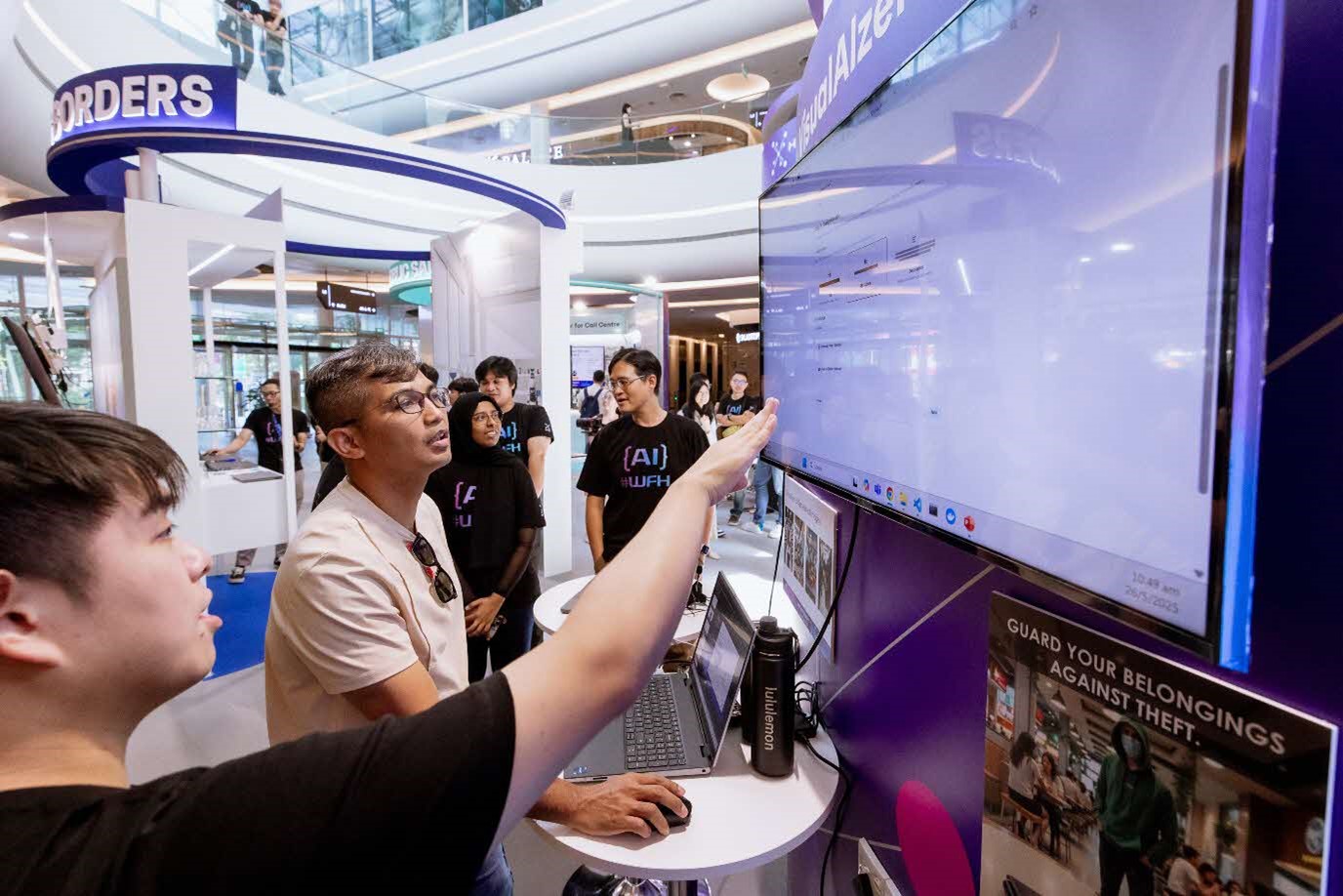 A visitor tries his hand at the VisualAlzer solution. (Photo: HTX)
A visitor tries his hand at the VisualAlzer solution. (Photo: HTX)

